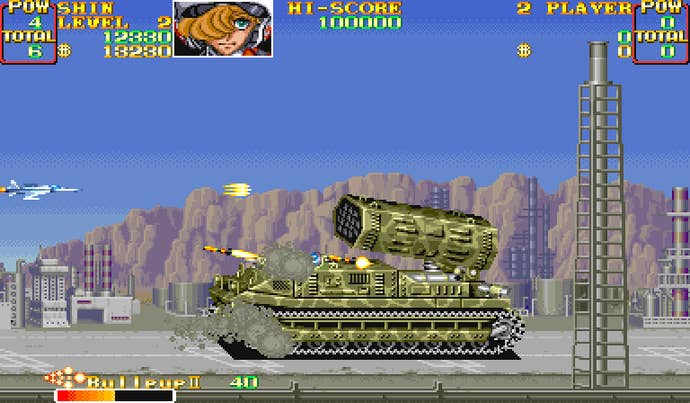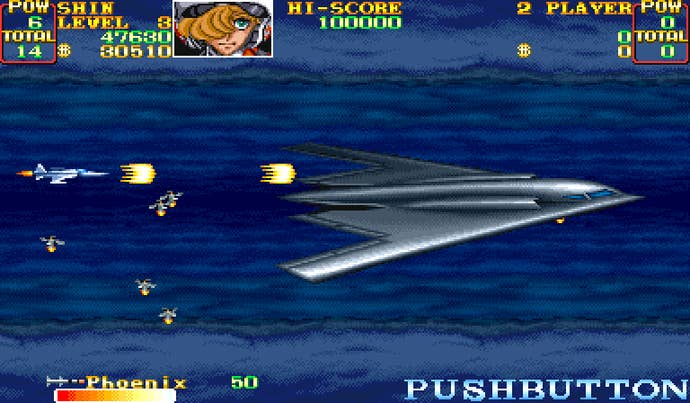Daily Classic: U.N. Squadron's SNES Identity Change
A solid shoot-em-up that was inflicted with a baffling identity crisis.
This article first appeared on USgamer, a partner publication of VG247. Some content, such as this article, has been migrated to VG247 for posterity after USgamer's closure - but it has not been edited or further vetted by the VG247 team.
In the grand pantheon of video games, not too many people remember Capcom's U.N. Squadron. It made a tiny ripple in the arcade and a somewhat more noticeable impact via its console conversion, thanks largely to being one of the first shooters on Super NES.
As shooters go, U.N. Squadron was pretty solid. It had that late '80s/early '90s Capcom vibe about it, which is to say that in addition to its excellent graphics and audio, it also offered a wealth of added features to give the button-mashing action some extra substance. Players could select one of three different protagonists -- the fast guy, the heavy-hitter, and the balanced generalist -- and, as usual for Capcom's action games, spend their combat earnings at the inter-level shop.

In many ways, U.N. Squadron felt like a variant on its sibling shooter 1943: The Battle of Midway turned sideways. Despite the difference in play style -- horizontal versus vertical -- it used a lot of the same tricks as its more popular counterpart. One-hit kills and multiple lives were deprecated in favor of a single red-gradiated life bar per credit, allowing a somewhat more generous (but nevertheless far from toothless) difficulty level than, say, Gradius or R-Type. It also allowed for two-person cooperative play, at least in the arcade.
U.N. Squadron didn't lack for spectacle. Dizzying formations of small fighters harassed the played en route to the enormous set piece boss. The boss encounters often broke from the fixed scrolling format, with players looping back and forth to dismantle massive enemy war machines. The stage three skirmish against a huge warship, for example, felt like a combination of 1943's aircraft carrier sequences and R-Type's battleship stage. The varied scenery kept things interesting, taking players high in the sky, over the water, into deep canyons, and more; so too did the shifting mission goals, such as clearing out enemy formations within a limited amount of time.

While the scenarios and bosses didn't always make sense -- was that Blackbird-style stealth fighter the size of the Spruce Goose really a logical feat of combat engineering? -- they certainly looked cool. So, too, did the players' choice of aircraft and their associated pilots; well, at least the dartlike F-20 Tigershark (flown by Shin Kazama, whose mop of hair all but obscured his vision) and the F-14 Tomcat (in true Top Gun style, its pilot Mickey Simon wore a rakish grin). The A-10 Thunderbolt looked as chunky as its Zangief-like pilot Greg Gates, but it made up for its lack of style with firepower and durability.
But there was something strange about U.N. Squadron, too; something that felt slightly off-kilter. There seemed to be an underlying narrative to the game, a bigger story that players only glimpsed a tiny fragment of. This certainly wasn't uncommon for arcade games of that era -- Capcom was, after all, the company that brought the world the enigmatic Strider -- but it seemed unusually prominent here. And what was with the shop system, which curiously refunded you for unused special weapons after each stage? Why did the runway in the opening cut scene read "A88"? And who was this mysterious "DAIPRO" credited on the title screen?
In truth, U.N. Squadron was a very thinly veiled licensed game... so thinly, in fact, that Capcom simply changed the name for the U.S. release. Shin Kazama and his comrades were all major characters from a long-running manga and anime property called Area 88, created by Kaoru Shintani -- hence the "A88" markings that appeared from place to place in the game -- and the game came over to the West with all names and references intact. The only major difference between the Japanese and English versions of the game, besides the language of the in-game dialogue, was the title. Why exactly the game's name had to change, but nothing else, is something of a mystery. By the time the game reached the U.S. in 1991, the manga had already been localized into English under its original title by Eclipse and Viz, so it's not as though "U.N. Squadron" was a prospective localized title.

Knowing the origins of U.N. Squadron goes a long way toward explaining some of its quirks. Despite the bolted-on title, the protagonists had nothing whatsoever to do with the United Nations; on the contrary, they were more akin to the Foreign Legion. Area 88 housed a squadron a mercenary pilots who operated under a contract obligating them to fly and fight in a semi-private turf war for three grueling years. Alternately, pilots could buy out their contract for $1.5 million -- hence the game's seeming obsession with tracking and refunding your earnings through the course of the story.
Anime-based game releases being distanced from their source material in the U.S. was hardly unusual in the late '80s, of course. Everything from Dragon Ball (aka Dragon Power) to Ranma 1/2 (aka Street Combat) was hacked and hidden, either to disguise the games' foreign origins or simply to reduce the obligation of license fees. U.N. Squadron, by comparison, seems like a demonstration of the least effort possible, like the time a kid in my second-grade class tore my name off my homework assignment and wrote his own name next to it. The teacher wasn't fooled for a second, yet my classmate feebly protested all the way down to the principal's office.
U.N. Squadron looks like it was ripped straight from the pages of Shintani's manga, regardless of what it was called or the hastily rewritten backstory. The inexplicable change turns a solid shooter into an odd little sidenote in video game history. Although actually, what's really weird is that Area 88's follow-up echoed the U.N. Squadron name change; since it didn't have the Area 88 license anymore, Capcom called it U.S. Navy instead. Well, that's what they called it in Japan, anyway; in America, it was bizarrely renamed Carrier Air Wing. So really, who even knows?








